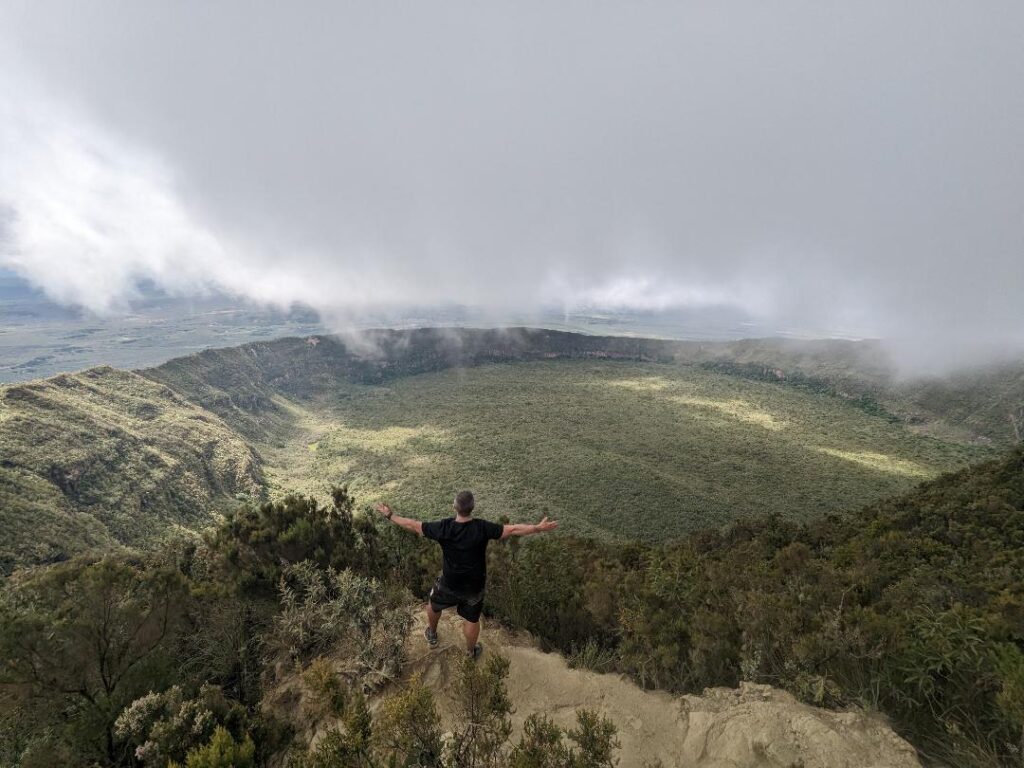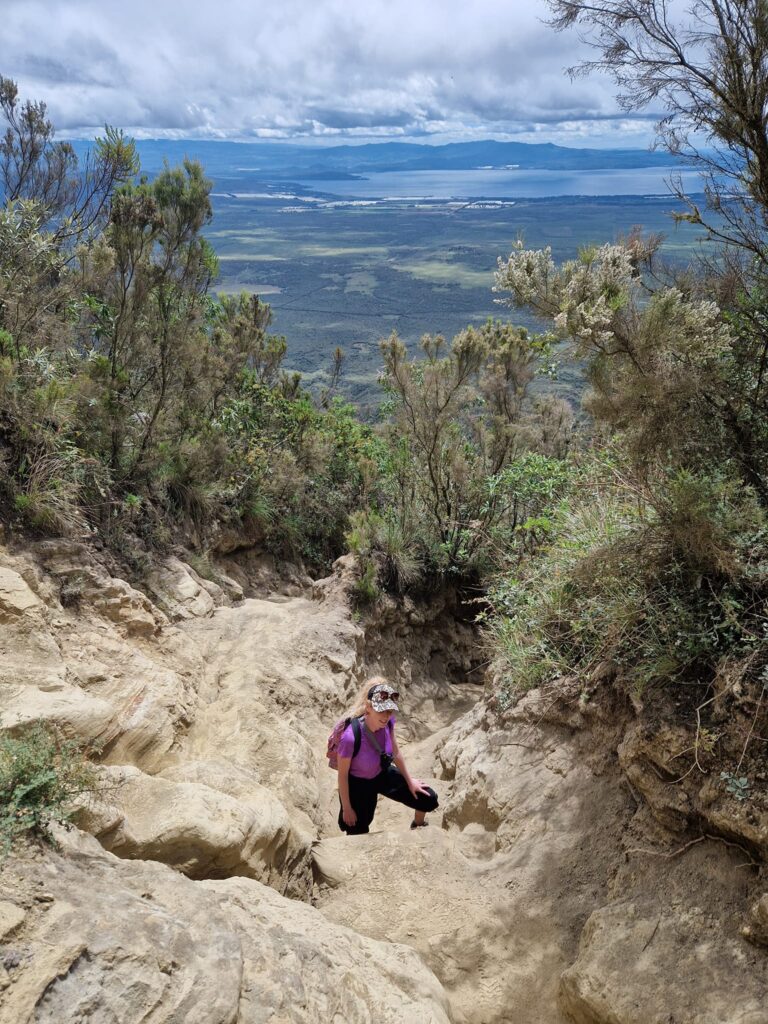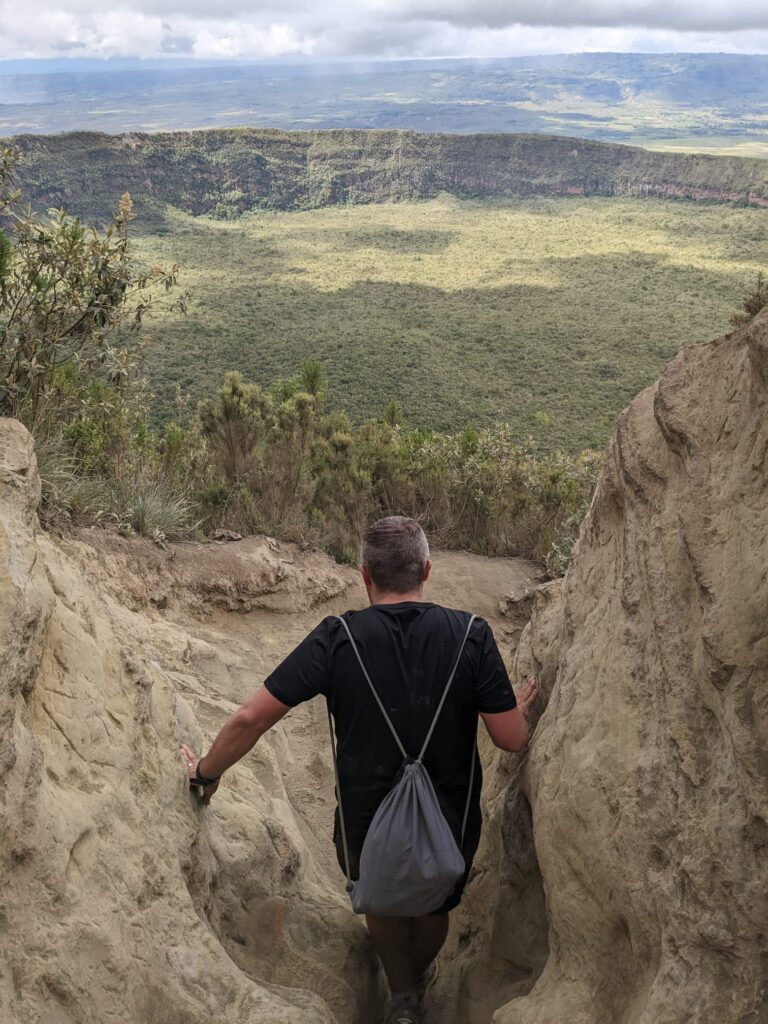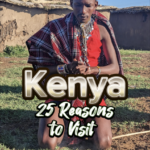Last updated on March 3rd, 2025 at 02:01 pm
One of our favorite experiences during our three-month stay in Kenya was hiking Mount Longonot, a massive volcanic crater in the heart of Kenya.
While Mount Kilimanjaro and Mount Kenya may steal the spotlight, Mount Longonot is a hidden gem that offers a truly unforgettable hiking experience with breathtaking views.
This volcano hike does demand a moderate level of fitness. However, the moment we laid our eyes on the stunning panoramic views of the volcanic rim, any fatigue in our legs quickly disappeared.
We’ve put together a list of frequently asked questions and their answers for those planning to go hiking in Mount Longonot National Park.
What is Mount Longonot?
Situated in Kenya’s renowned Great Rift Valley, Longonot is a dormant volcano featuring a moderately challenging hiking trail leading to its stunning crater rim and summit.
The reason why hiking Mount Longonot is considered moderate is because of the constant uphill hiking to the summit which stands at an elevation of 2776 meters above sea level.
However, once you reach the rim, you’ll be rewarded with breathtaking views of a dense forest that grows within the magnificent crater, almost resembling a secret Garden of Eden. In fact, the densely forested crater floor is a self-contained ecosystem, how cool is that!

The name “Mount Longonot” is derived from the Maasai word “Oloonong’ot”, which translates to “mountain of many steep ridges”. As you gaze upon the mountain, it’s not hard to see why!
This was one of the best hikes in Africa, during our 9-month Egypt to South Africa adventure.

If you’re planning a hike to the top of the mountain, you’ll need to climb about 900 meters in elevation to reach the summit. The good news is that if you just want to hike up to the edge of the crater, you’ll only have to climb about 600 meters. Regardless of how far you go, what is certain is that your heart will be pumping the entire way!
Check out some of our best hikes in the world:
- Mount Bromo in Indonesia
- Fann Mountains in Tajikistan
- Living Root Bridges of India
Where is Mount Longonot Located?
Mount Longonot is situated 90 kilometers (56 miles) northwest of Nairobi, the capital city of Kenya. The nearest town to Mount Longonot is Naivasha, which is located around 30 kilometers away and is the perfect place to base yourself for a few days.
While in this part of Kenya, check out the best things to do in Naivasha.
You will find a range of affordable self-catering apartments in Naivasha while planning your Mount Longonot hike or exploring nearby popular Kenya attractions on a Hells Gate and Lake Naivasha day trip.
Getting To Mount Longonot
From Naivasha to Mount Longonot National Park is quite easy and can be very cheap!
Our way – Of course, we chose the cheapest way which was by local transport. The main supermarket in Naivasha is “Naivas” and this is where all the local minibusses (called Matatus) depart from. Ask for the minibus to the town of Longonot and you will be guided to the correct matatu, this should cost only 100 Kenya shillings.
Get off in the town of Longonot, and from there you will get a motorcycle taxi to the entrance of the national park. Even though this is a much shorter trip, the motorbike ride will cost you 200 Kenyan shillings. Welcome to Africa where prices often don’t make sense!

When you reach the entrance gate of Longonot National Park, coordinate with your motorcycle driver to call him when you’re finished, and he will pick you up and drop you off at the matatu stop on the way to Naivasha.
Don’t freak out when he drops you off on the side of the road. In Kenya, matatus operate by picking up passengers who flag them down as they pass by, and you get into a minibus that is more than likely jam-packed! Luckily it’s only a short journey!
Taking a matatu (minivan) and motorcycle is the most budget-friendly option to get to Mount Longonot National Park from Naivasha, but might not suit everyone.
Taxi – In addition to matatus, you can also hire a taxi to get to Mount Longonot National Park from Naivasha. Depending on your negotiating skills, you can expect to pay around $20-$30 in total. This is a great option if you’re traveling with a group, but where’s the fun in that?!
Don’t forget to clarify with the taxi driver that they will wait for you while you hike Mount Longonot. This should be included in the negotiated price.
From Nairobi – If your time is limited, you can take a day trip to Mount Longonot from Nairobi, Kenya’s capital city. You have three options to visit Mount Longonot from Nairobi.
- The journey from Nairobi to Mount Longonot National Park will take around 2 hours by car, so make sure to leave early. For a group the best option would be hiring a private driver for the day, prices range from $50 to $120 depending on your negotiation skills. This does not include the entrance fee.
- If you prefer the freedom to explore at your own pace, renting a car in Nairobi instead of hiring a private driver is a great option.
- The final option is to be part of an organized tour from Nairobi to Mount Longonot. This option often provides the most convenient way to get to Mount Longonot National park, as well as additional benefits such as a guided tour, transportation, and logistical support. If you like the sound of that then check out the link below and support Happy Irish Wanderers – Thank you!
Mount Longonot Entrance Fee and Opening Hours
The Mount Longonot National Park is open for 12 hours every day from 6:00 AM to 6:00 PM.
Non-resident adults must pay 33.000 Kenyan Shilling, (26 USD) for the Mount Longonot entrance fee. However, for Kenyans, the Mount Longonot entrance fee is nearly a tenth of the price at only 300 Kenyan Shillings (2.5 USD)
Add this Mount Longonot hike to your epic Africa itinerary where we bring you on the ultimate Africa adventure to experience it all.
How Difficult is it to Hike Mount Longonot?
The entire duration to hike Mount Longonot takes 4-6 hours and can be divided into two stages.
The first stage is the 3.1-kilometer hike to the crater rim which takes around one hour, depending on your fitness. This can be steep in certain parts, but just think of the reward once you get to the crater rim!

Once you reach the rim, you have the choice to descend and head back to the gate or hike all the way around Mount Longonot’s crater for the second stage.
The crater rim is massive and this will add 7.2 km to the hike, taking 2 to 3 hours. Along the way, you will have a few more short but steep inclines, loose gravel, and rocky paths.
The good news is that the views are like stepping back in time to a Jurassic Park world.
Besides the stunning views of Mount Longonot’s crater rim, you will also be treated to gorgeous views of The Great Rift Valley, Hell’s Gate National Park, Lake Naivasha, and the surrounding volcanic grounds of Mount Longonot National Park.
Once you reach the viewpoint where you started, you simply follow the track back down towards the entrance gate. Altogether the hike up to the viewpoint of the crater and the hike around the rim of Mount Longonot is 13.5 km, just under 9 miles.
Do I Need a Guide to Hike Mount Longonot?
A guide is NOT compulsory for hiking Mount Longonot, as long as you stick to the well-marked track that leads to the rim, follow it around in an anti-clockwise direction, and follow the track back down, you will not have any issues.
However, some visitors prefer hiring a guide for added safety and information about the area. It comes down to personal preference.

If you’re comfortable navigating trails independently and have some hiking experience, you can hike Mount Longonot without a guide and have no problems.
Will I See Wildlife During The Mount Longonot Hike?
While Mount Longonot National Park doesn’t have the same abundance of wildlife as Maasai Mara National Reserve, you will encounter some iconic African animals within the national park grounds.
Within five minutes of entering Mount Longonot National Park, we were greeted by the sight of giraffes, zebras, and gazelles. What an African experience this was!

On the way down, we came across another large herd of zebras and gazelles, casually looking at two very tired Happy Irish Wanderers!
Essential Items To Bring For Hiking Mount Longonot
Hiking Mount Longonot will take an average of 4 to 6 hours, and you will not have access to any shops along the way. This means it’s crucial to be well-prepared and bring all the essential items you might need for your hike.
Below is a basic list of what we recommend for hiking Mount Longonot.
- A minimum of 2 liters of water per person. (You can leave extra water at the entrance gate to have when you return from your hike).
- Plenty of food to keep your energy levels up. The matatus depart from the largest supermarket in Naivas, which also has a hot deli offering a variety of items, including sandwiches, samosas, and cakes.
- Bring a warm top, it can be quite cold and windy at the rim. (see rain jacket below in summary)
- Sun protection – hat, sunglasses, and sunscreen.
- Following the hike, you will be sweaty and covered in dust. If you plan to return to Nairobi on the same day, it’s advisable to pack a complete change of clothes. (Warm top, t-shirt, shorts, socks and flip flops)
When is the Best Time to Hike Mount Longonot?
The best times to visit Naivasha and, therefore the best time to hike Mount Longonot, are typically during the dry seasons, from January to March and June to October.

The dry seasons offer the best chances of clear skies and minimal rainfall.
Hiking Mt Longonot: Final Tips
- Make sure to check the weather forecast before hiking Mt Longonot. Rainy weather more than likely means cloudy conditions at the summit. This will make your hike nearly pointless as there will be no view at the rim of Mount Longonot.
- Plastic bottles are prohibited within the park. We personally didn’t face any issues with that rule, and we weren’t asked to display the contents of our daypacks, despite each of us carrying two plastic bottles. Just be aware of this rule.
- Having said that, bring your rubbish back down with you, don’t be that person!
- Encounters with wildlife are possible, so it’s important to show respect and maintain a safe distance to ensure the well-being of you and the animals.
Are you planning a trip to Naivasha and Mount Longonot National Park? If you have any questions or concerns, we’re here to help answer them and provide you with all the information you need to make your trip a success. Please feel free to leave us a message below or contact us through our socials.
Slán go fóil


This post contains affiliate links. If you click on the links to make a purchase, we will earn a small commission. This is at NO EXTRA COST to you. This is a free way to support us and allow us to continue to create inspiring adventure travel guides.







